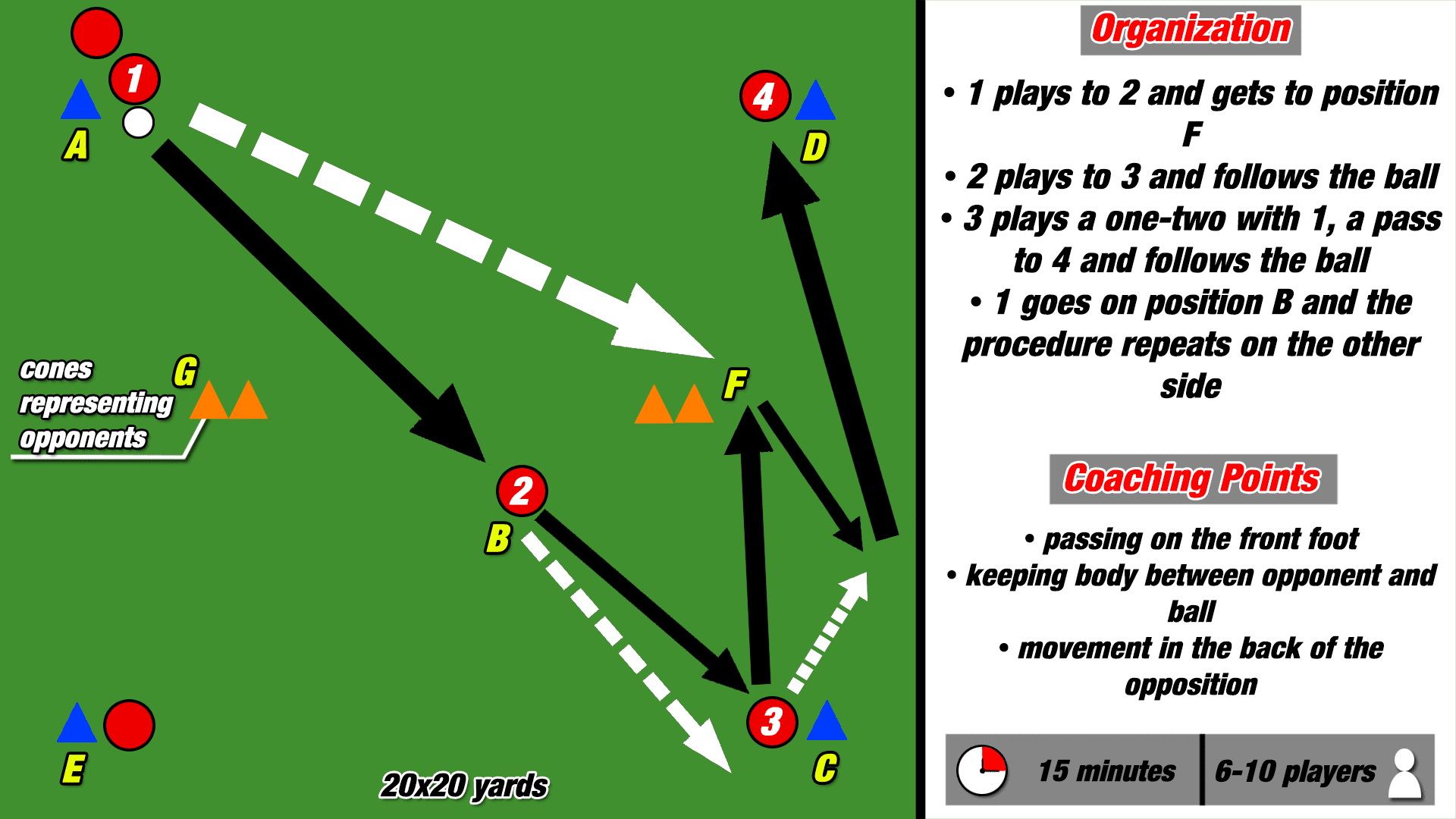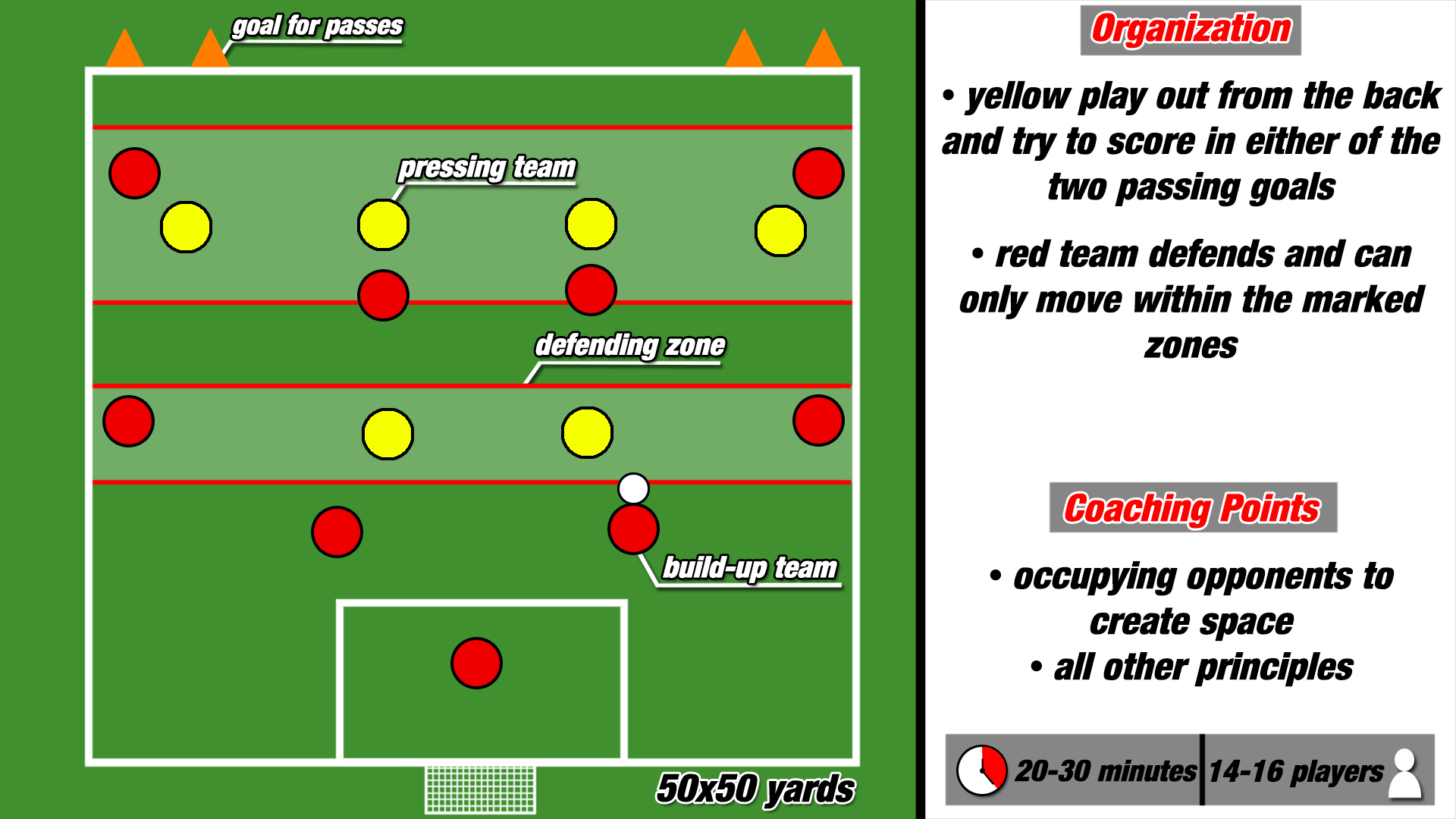Coaches like Guardiola, Sarri and Favre impressed with their courageous philosophy of playing out from the back. Why one should follow this path in youth teams and how you can practice to play out from the back in your training sessions will be explained in the following.
The concept of playing out from the back
Playing out from the back basically means to progress up the pitch with clear passes even under the highest pressure. The intention lying behind this idea is to overplay opponents and thereby create promising situations higher up the pitch. One of the coaches who heavily influenced Guardiola’s philosophy, Juanma Lillo, describes the advantage of playing out as follows:
“Everything is much easier if the first progression of the ball is clean.” (Lillo)
Napoli under Sarri in 2017/2018 is one of the best examples of a side that successfully played out from the back. Depicting Napoli’s way to build-up play, it becomes clear that every pass is played to either progress up the pitch or to get a new angle of attack in order to be able to break lines of the opposition. Every action is subordinated to the main goal to overplay opponents.
Successfully playing out from the back is an important concept when it comes to youth training as it teaches players how to play under pressure. In the long-term, the approach of intentionally building up from the back is a more promising one than to play long balls which are often connected to a lot of coincidence. Since the pressure to achieve good results is lower, short-term miscues should be acceptable in youth football. In general, playing outlays the foundation of a dominant possession style of football.
Principles when playing out from the back
To make your players understand the game, one should teach them several principles. By deploying these principles the players will be able to make the right decision under pressure.
Firstly, when playing out from the back, one should always aim at penetrating defensive lines and progressing up the pitch. Although patience is needed, every player should check whether a pass into depth without losing the ball is possible. Especially if the opposition is pressing high, there will appear space between the lines which needs to be exploited. If there is no space, this means that the opponent has heavily shifted towards the ball, opening up space on the ball far side. If none of these areas are exploitable, one needs to further stretch the opposition. That is possible with backwards passes. These assumptions create our first principle:
#1 First look deep, then wide and last but not least backwards!
In a scenario where the opposition is not pressing high but just shifting horizontally, your team has to make sure to create gaps on your own. Therefore it is necessary to occupy opposition players to then find a spare man. When a centre-back, for example, dribbles towards the opposition block, the opponent will try to get into an even more compact shape to avoid passes into their block. That way, one creates space around the block. In general, if the opponent is not moving, make them move.
#2 Always occupy opponents and then accelerate circulation to exploit the created space.
Since playing out from the back is an approach of a possession phase, some basic principles of the possession phase are relevant. There are endless directions a ball can be played. However, if one simplifies it, there are only three options: diagonal, vertical, horizontal. Depicting the effect of a pass that is played diagonal/vertical/horizontal, there appear clear preferences. Whereas a ball that is played diagonally can overplay vertical and horizontal lines of the opposition, a vertical or horizontal pass only overplays either vertical or horizontal lines. Moreover, receiving a diagonal ball is easier since you can position yourself sideways seeing ball and goal at any time (open body shape).
#3 Diagonal > Vertical > Horizontal
As mentioned earlier, one should always attempt to progress up the pitch when playing out from the back. Small details can decide whether a player can turn and play on forwards. If possible, your players should always play a pass onto the front foot of the receiving player. That way, the player can face the opposition goal when receiving and it is more likely that he spots a spare man in a more advanced area. Furthermore, if the receiving player has space in front of him, one should play the ball into the space to enable progression up the pitch.
#4 Pass onto the front foot or into space, if possible.
Furthermore, the body shape of the receiving player, the first touch, verbal and non-verbal communication between players and many other individual principles affect the success rate when playing out from the back. Since that goes beyond the scope of our article, we have limited the principles to the most important ones. But as an advice for any coach: Even the smallest detail can have a huge impact on the game.
Drills to practice playing out
Since playing out from the back means circulating the ball under high pressure, players need to be really precise. Therefore, the use of passing patterns in the warm-up phase suit to a session focusing on playing out from the back. Combining technique and some individual tactical aspects is sensible as players already learn how to prepare the next action with their pass. The following passing pattern of Daniel Niedzkowski (German head coach instructor) combines the mentioned aspects.

The pattern begins with a pass into the centre followed by turning and playing diagonally to the next station. Then, the ball is played long-line after a wall pass of another player (Up-back-up combination). From then on, the same combinations are repeated in the other direction. The beginning of the following video shows the above illustrated passing pattern with instructions of Niedzkowski (in German).
In this simple drill, one can already teach players to play passes onto the front foot of their teammates. Moreover, it teaches the athletes to play into depth if possible. And last but not least, one can already coach the positioning of players in central areas. Explain them to stay in the back of the opposition since this enables overplaying opponents.
Playing out from the back needs confident players. Your players will gain this confidence from experiencing match-like scenarios in practice. That is why the last drill is kept close to the actual match.

This practice simulates an 8v6 build-up situation. The team in possession has to play out from the back to score in passing goals at the halfway line. The defending team is only allowed to defend within their zones. That simplifies playing out and thereby allows you to teach your players certain movements. Whenever the pressing team win the ball, they are allowed to counter-attack on the goal. After one counter-attack, play starts again with a goal-kick from the goalkeeper.
To challenge the players, one can remove the defending zones and stock up the team in defence with one or two further players (8v7/8v8). Remember also to encourage the goalkeeper to participate in build-up play as (s)he can be the spare man.
Conclusion
Playing out from the back is a courageous approach which needs confident players. Therefore, practising to play out from the back needs time. Nevertheless, it is an important aspect of youth training. Keeping the drills as simple and game-related as possible will enable you to teach your players the presented principles. That way you can lend your team even more dominance in the long-term.




Comments